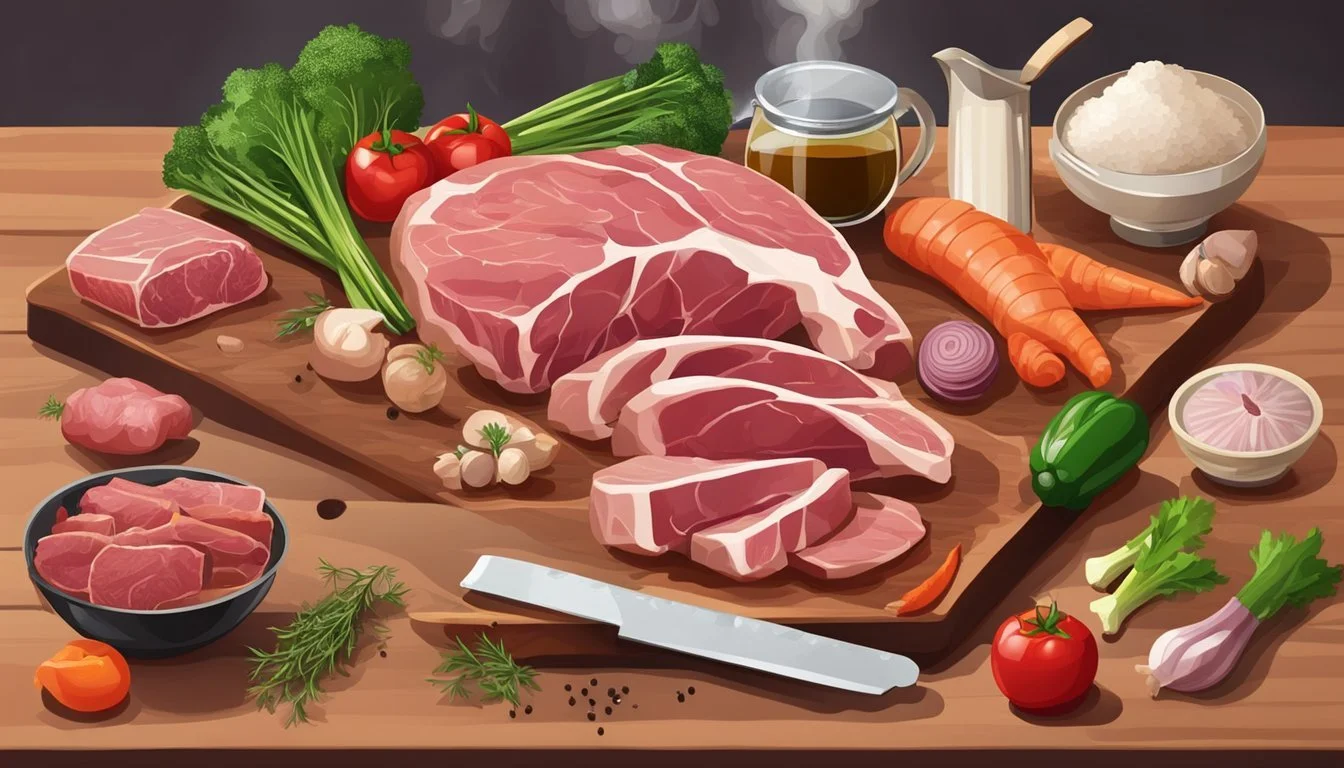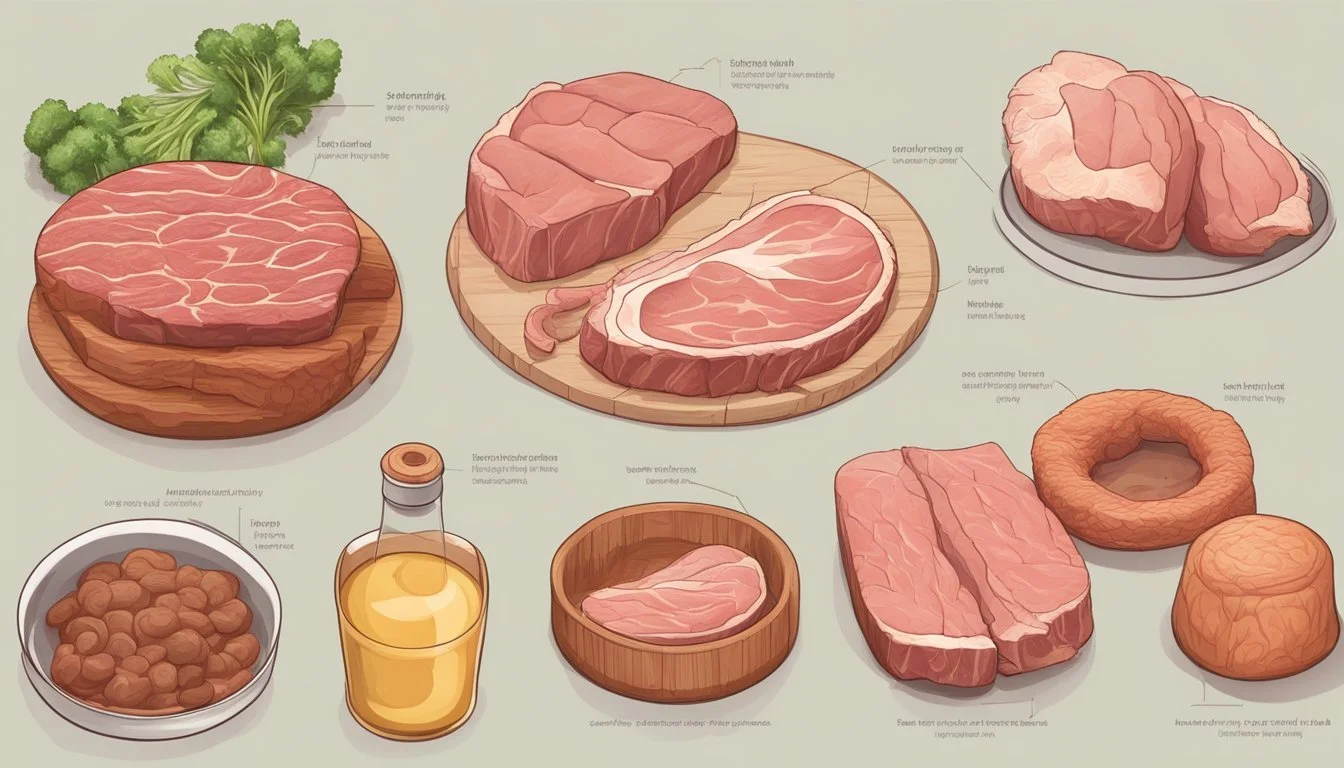Carnivore Diet Edema
Understanding Causes and Management
This Article is Part Of Our Guide on the Carnivore Diet
The carnivore diet, an animal product-only eating regime, emphasizes a high intake of meat and animal fats while excluding all plant-based foods. It has been associated with various health improvements such as enhanced body composition and relief from certain chronic conditions. However, individuals who adopt this diet may experience a range of side effects, including edema – the medical term for swelling caused by fluid retention in the body’s tissues.
One possible explanation for edema on a is the substantial increase in dietary sodium through high salt content in some meat products, which can disrupt the balance of electrolytes in the body. Additionally, a significant change in macronutrient intake necessitates an adjustment period, during which the body must adapt to a higher fat consumption, potentially leading to digestive challenges and fluid retention.
While some individuals report positive health outcomes on the carnivore diet, those considering this significant nutritional shift should be aware of potential side effects such as edema. It is important to monitor the body’s response closely and consider professional medical advice to manage and mitigate these adverse reactions effectively. Consulting a healthcare professional before starting the carnivore diet is highly recommended.
Understanding the Carnivore Diet
This section provides a detailed look at the carnivore diet, outlining its fundamental principles and how it compares to other dietary approaches. The carnivore diet offers significant benefits, particularly through high-quality proteins and collagen.
Definition and Principles
The carnivore diet, often considered an extreme form of a low-carbohydrate, high-fat diet, eschews all plant-based foods in favor of exclusively animal-derived products. Its primary focus is on only meat, including beef, chicken, and fish, as well as animal fats and offal. Proponents argue that this zero-carb approach can lead to various health benefits and that humans can thrive on a diet rich in proteinfats, without the need for dietary carbohydrates. The carnivore diet can be seen as a more restrictive version of the paleo and keto diets, removing even the limited plant-based foods those diets allow.
Food Sources
Description: Exclusively animal products
Carbohydrate Intake
Description: None; a zero-carb diet
Diet Composition
Description: High in protein and animal fats
Excluded Items
Description: All plant-based foods and carbohydrates
Comparison to Other Diets
When comparing the carnivore diet to other dietary modalities like the paleo or keto diets, clear distinctions emerge. While both the paleo and keto diets limit carbs, they incorporate a variety of plant-based foods. The paleo diet does not allow for processed foods and grains but includes fruits, vegetables, and nuts. The keto diet puts a cap on daily carb intake to promote a state of ketosis where fats are burned as the primary fuel source instead of carbs.
The carnivore diet takes the concept of a low carb diet to the ultimate level, eradicating carbs entirely. Its advocacy for consuming only animal products stands in stark contrast to the balance of proteins, fats, and limited carbs seen in other low-carb diets. It is important to note, however, that while some individuals report improved health outcomes on the carnivore diet, such as enhanced mood and resolution of certain medical conditions, it remains a point of controversy among health experts due to the potential risks and absence of long-term studies.
Potential Health Benefits of the Carnivore Diet
The carnivore diet, an all-meat regimen, is gaining attention for its potential health advantages, particularly in weight management, reducing inflammation, and influencing digestive health. Additionally, the carnivore diet can support sustainable weight loss if properly managed.
Weight Loss Effects
Individuals following the carnivore diet often report significant weight loss. The diet’s high protein and fat content may lead to an increased feeling of fullness, reducing overall calorie intake and potentially creating a calorie deficit without the need for deliberate calorie counting. The absence of carbohydrates in the diet can also lead to a state of ketosis, where the body begins to burn fat for energy, potentially contributing to weight loss.
Inflammation and Immune Response
A carnivore diet may lead to a reduction in inflammation, as reported by some of its proponents. The elimination of plant-based foods, which can contain anti nutrients, might contribute to a decrease in inflammatory symptoms for some individuals. It is also hypothesized that the high levels of omega-3 fatty acids found in certain meats like fish can support anti-inflammatory processes.
Impact on Digestive Health
The impact of the carnivore diet on digestive health can vary, with some experiencing relief from digestive discomfort. Without plant-based fibers, some may experience relief from diarrhea or constipation, while others might experience an increase in such symptoms. The diet’s focus on nutrient-dense foods can provide essential vitamins and minerals that support overall health, but the absence of fiber again raises concerns regarding long-term gastrointestinal function and the balance of gut microbiota.
The Carnivore Diet and Edema
Edema, or water retention, can occur for various reasons, some of which may be influenced by dietary choices such as the carnivore diet. High levels of sodium can cause the body to retain water, leading to edema. This section examines potential causes and management strategies for edema among individuals following this diet.
Causes of Edema While on Carnivore Diet
Sodium Intake: The carnivore diet often contains high levels of sodium, which can contribute to water retention. Sodium causes the body to hold extra fluids in the cells, resulting in symptoms of swelling and puffiness. Additionally, the depletion of glycogen stores due to low carbohydrate intake can also contribute to water retention.
Electrolyte Imbalance: A shift in electrolyte balance, particularly affecting magnesium and potassium levels, can result in edema. These electrolytes are crucial for maintaining fluid balance, and their absorption can be inhibited by factors present in the carnivore diet, like coffee consumption.
Managing Edema Symptoms
Adjust Sodium Levels: To alleviate symptoms of edema, individuals may consider moderating their sodium intake. A lower salt version of the carnivore diet could potentially reduce water retention.
Electrolyte Supplementation: Incorporating supplements to restore electrolyte balance can help manage edema. Magnesium supplementation, for example, may counteract the negative effects of excess sodium and help to regulate fluid balance. Additionally, individuals can slowly increase their intake of certain foods, such as vegetables, to help manage edema symptoms.
Nutritional Considerations and Risks
The carnivore diet, while simple in premise, presents several nutritional considerations and risks, including nutrient deficiencies, that need to be carefully managed to maintain health and prevent complications such as edema.
Vitamin and Mineral Intake
The carnivore diet typically excludes plant-based foods, which are traditional sources of several essential vitamins and minerals. Key nutrients that may be deficient include Vitamin C and certain B vitamins, as well as minerals like magnesium. To prevent deficiencies, individuals must select a variety of animal-based foods that can provide these nutrients, such as organ meats for B vitamins and shellfish (What wine goes well with shellfish?) for magnesium. Some individuals may include dairy products to help meet their nutritional needs.
VitaminsLiver for B vitamins; potentially supplement with Vitamin C
Minerals
Magnesium: Shellfish, fish
Sodium: Naturally present in meat; intake usually adequate
Risks Associated with High Fat Intake
A diet rich in animal products is inherently high in fat, which can impact body fat and cardiovascular health by affecting cholesterol levels and blood pressure. Saturated fats and cholesterol can accumulate, potentially leading to atherosclerosis or heart disease if not carefully managed with regular health monitoring.
Fat intake: Predominantly from animal-based foods
Cholesterol: Monitoring levels is crucial
Long-Term Health Implications
Long-term adherence to a carnivore diet may strain the body's kidneys, liver, and gallbladder due to the increased workload of processing proteins and fats. There is also an ongoing debate about the impact of a high-animal fat diet on systemic inflammation and subsequent health issues like edema. Regular health assessments are necessary to ensure these organs are not overburdened and to adjust the diet as needed to prevent long-term damage.
Organ Health:
Kidneys: Protein filtration demands
Liver: Fat processing and cholesterol management
Gallbladder: Increased bile production due to fat digestion
Adapting to the Carnivore Diet
When individuals switch to a new diet like the carnivore diet, they may encounter an adaptation period where their bodies adjust to high-protein and fat consumption. This transition can come with several side effects, but with the right strategies, these can be managed effectively.
The Adaptation Period
During the initial weeks of the carnivore diet, one may experience a series of physiological changes as the body adjusts to high-protein and fat consumption, switching from using carbohydrates to fats as its primary energy source. This adaptation period can vary in duration and intensity depending on past dietary habits and individual metabolism. Common symptoms during this time include:
Cravings for carbohydrates as the body depletes its glucose stores
Nausea and headaches resulting from electrolyte imbalances
Irritability and brain fog due to temporary drops in blood sugar levels.
Overcoming Common Side Effects
As the body adapts to the carnivore diet, several side effects, including digestive issues, may be present. These can include, but are not limited to:
Bad breath and night sweats, which may occur as byproducts of increased protein metabolism
Muscle cramping and insomnia, potentially linked to shifts in mineral levels and hydration status.
Managing these symptoms often requires attention to:
Bad Breath
Strategies: Increase hydration, practice oral hygiene
Cramping
Strategies: Supplement with electrolytes
Insomnia
Strategies: Establish a regular sleep routine
Night Sweats
Strategies: Maintain a cool sleeping environment
Brain Fog
Strategies: Ensure adequate food intake
Tips for Managing Transition
To ease the transition into the carnivore diet and reduce potential side effects, consider adopting the following approaches:
Hydration: Drink plenty of water to support metabolic processes and removal of waste products.
Electrolytes: Balance sodium, magnesium, and potassium intake to mitigate cramps and headaches.
Mindful Eating: Pay attention to natural hunger cues to prevent undereating which can exacerbate adaptation symptoms like irritability and brain fog.
Patience: Understand that the body needs time to adapt and symptoms are usually temporary.
By incorporating these strategies thoughtfully, individuals can manage the transition period effectively and settle into the carnivore diet with greater ease. Additionally, intermittent fasting can be a helpful strategy for managing the transition.
Carnivore Diet and Body Functioning
Engaging in a carnivore diet prompts various physiological adaptations within the body. These changes can affect metabolism, hormone levels, and the digestive system. Maintaining lean muscle mass is important for overall health.
Metabolic Changes
On a carnivore diet, metabolism shifts from utilizing carbohydrates to burning fats for energy. With the elimination of dietary carbohydrates, the body’s glucose levels decrease, necessitating a different energy source. This adjustment period can result in changes in energy and potentially affect exercise performance. Over time, individuals may experience a state of ketosis where their body becomes efficient at burning fat for fuel. Initially, individuals may also lose water weight due to the depletion of glycogen stores.
Hormonal Impacts
The carnivore diet can impact hormone production and regulation significantly. For instance, the absence of carbohydrates may lower insulin spikes, affecting how the body manages blood sugar levels. Cortisol, a hormone associated with stress, may also be influenced by drastic dietary changes and can affect mood and sleep patterns. Additionally, dietary changes can cause fluctuations in other hormones that contribute to the body’s equilibrium.
Digestive System Adjustments
Removing plant fibers from the diet leads to a substantial change in digestive functions, including potential bloating. This could initially give rise to digestive issues as the colon adjusts to the high fat and protein intake. Nevertheless, with the absence of fiber, some people may notice an improvement in certain chronic digestive conditions. It’s also worth noting that the pancreas might work differently in the production of digestive enzymes to break down the increased protein load.
Incorporating Exercise and Lifestyle Habits
In addressing edema within the scope of a carnivore diet, one cannot overlook the interplay of exercise and lifestyle habits. They are pivotal in managing body weight, fluid balance, and enhancing overall health.
Importance of Physical Activity
Exercise is indispensable for those on a carnivore diet facing issues like edema. Physical activity helps boost metabolism, which in turn can facilitate fluid balance and reduce swelling. Incorporating a mix of strength training and aerobic exercises can aid in increasing muscle mass and improving cardiovascular health. For instance:
Strength Training: Engage in compound lifts two to three times a week.
Squat
Deadlift
Aerobic Exercises: Aim for low to moderate-intensity activities daily or most days of the week.
Brisk walking
Cycling
Consistent exercise may also elevate mood and energy levels, contributing to a more positive outlook on one’s health journey. Additionally, consistent exercise can aid in fat loss and improving cardiovascular health.
Sleep and Recovery
Adequate sleep is essential for the body's ability to recover and rebuild. Adults typically need 7-9 hours of sleep per night for optimal hormone function, which plays a crucial role in managing inflammation and metabolism. Here’s how individuals can better manage their sleep:
Maintain a consistent sleep schedule.
Create a sleep-conducive environment: dark, quiet, and cool.
Stress Management
Managing stress is as critical as diet and exercise in dealing with edema. Increased stress can lead to hormonal imbalances that might worsen edema. To keep stress in check, one could:
Practice mindfulness or meditation.
Engage in relaxation practices like yoga.
Implementing stress-reduction techniques can improve recovery and energy management, ensuring that physical exertion is not counteracted by high-stress levels. This holistic approach to health and well-being is key for anyone on a carnivore diet facing the challenge of edema. Additionally, implementing stress-reduction techniques can improve overall well being.
Carnivore Diet Food Selection and Preparation
Selecting appropriate meats and fats is critical on a carnivore diet, and once chosen, they must be prepared in ways that preserve their nutritional value while making them enjoyable to eat. Additionally, refined sugars should be avoided to maintain the principles of the carnivore diet.
Choosing the Right Meats and Fats
When adhering to the carnivore diet, the individual should focus on:
Meats: Opt for a variety of meats including beef, pork, lamb, and seafood to ensure a broad intake of nutrients. Grass-fed and organic options are preferable for higher quality fats and fewer unwanted additives.
Animal Fats: Incorporate natural animal fats for cooking and consumption. This can include fats from meat cuts, lard, and tallow.
Dairy: Though controversial in the carnivore community, some people may include dairy products like cheeseeggs. One should aim for full-fat, minimally processed options to stay true to the diet’s principles.
Low carb vegetables are excluded from the carnivore diet.
Cooking Techniques and Ideas
It is essential for one to employ cooking techniques that highlight the natural flavors and textures of the meat without introducing prohibited ingredients:
Simplicity: Cooking methods like grilling, roasting, and searing typically enhance the meat’s taste and can be more conducive to this diet’s restrictions.
Bacon: A versatile addition, bacon can be used not just as a dish on its own, but also as a way to add flavor to other meats.
Avoidance of Frying: Due to the potential introduction of non-animal fats and breadings, frying is often discouraged unless using animal fats like lard.
Eliminating processed foods can further enhance the natural flavors of the meat.
Foods to Avoid
While on the carnivore diet, the food items to be strictly avoided include:
Sugars and Processed Foods: The carnivore diet eliminates sugars, processed foods, preservatives, and chemicals commonly found in the modern American diet.
Plant-Based Foods: All vegetables, fruits, nuts, seeds, and grains are to be eliminated from the diet.
Non-Carnivore Fats: Exclude any fats that are not directly sourced from animals, such as vegetable oils and margarine.
By being discerning with one’s food choices and preparation methods, individuals can adhere to the specific requirements of the carnivore diet while enjoying a variety of delicious and nutrient-dense meals.
Common Questions and Misconceptions
In exploring the carnivore diet, concerns such as edema, health implications, and sustainability of a highly restrictive, zero-carb regimen arise frequently. This section addresses prevalent myths and provides answers to common health-related questions associated with the carnivore diet. Additionally, various dietary factors, including processed foods and nutrient imbalances, can negatively impact weight loss efforts.
Addressing Carnivore Diet Myths
**Myth 1:**Consuming a high amount of animal fat leads to weight gain and health issues. While it is true that the carnivore diet is high in animal fats, it is not necessarily linked to weight gain or poor health outcomes if properly managed. Similar to the ketogenic diet, the body utilizes fats from the diet as an energy source, especially when carbs are absent. Studies have not consistently shown a direct correlation between saturated fat intake and cardiovascular health problems. However, individuals on the carnivore diet should monitor their overall caloric intake and health parameters with a medical professional.
**Myth 2:**The carnivore diet causes low energy levels due to the absence of sugar and plants. Carbohydrates, including sugars, are a common energy source for most diets. On a carnivore diet, where these are absent, the body can adapt to use fats and protein for energy in a state of ketosis. Initially, some might experience a transition phase of lower energy, but this is not typically sustained in the long term.
FAQs About Carnivore Diet and Health
Q: Can the carnivore diet lead to health problems like insula (edema)? A: Edema, or insula, is not commonly reported as a direct result of a carnivore diet. The condition is characterized by swelling caused by excess fluid trapped in the body’s tissues, and it can have numerous causes, including dietary factors. The carnivore diet, being very high in protein, has been claimed to impact kidney function negatively, potentially leading to issues like edema, but these claims require further research for definitive conclusions. It is important for individuals to ensure they consume adequate electrolytes to balance fluids within the body. The carnivore diet also focuses on nutrient dense foods to support health.
Q: Is the carnivore diet too restrictive and unsustainable? A: Critics often label the carnivore diet as restrictive due to its elimination of carb sources, including plants and sugars. The sustainability can vary significantly among individuals, based on personal health needs, preferences, and the body’s response to such a diet. Some may find the diet unsustainable long-term, while others report improved health markers and well-being. Always seek guidance from health professionals when undertaking a restrictive dietary regimen.
Conclusion and Key Takeaways
The carnivore diet is a dietary regimen focused exclusively on the consumption of animal products. Those who adopt this lifestyle exclude plant-based foods with the belief that it aligns more closely with human ancestral eating patterns. This diet has been associated with several health reports, both positive and negative.
Nutritional Intake: A strict adherence to animal products can result in a nutrient-dense intake, particularly with regard to protein and certain fats. However, individuals should consider supplementing to avoid potential deficiencies, particularly in vitamins and minerals typically abundant in plant foods.
Health Considerations: The diet’s implications on health can vary. While there are anecdotal reports of improved health markers, one should exercise caution and seek medical advice before starting such a restrictive diet. Monitoring is crucial to ensure that issues like edema—a condition that can stem from nutritional imbalances—are promptly addressed.
Commitment and Customization: Commitment to the carnivore diet requires a significant adjustment period and ongoing reassessment of bodily responses. It may be necessary to tweak one’s dietary intake to mitigate adverse effects and support overall well-being.
Tips and Tricks: Gradual implementation may ease the transition. Start by slowly increasing meat intake while decreasing plant-based foods.
Hydration: It’s important to maintain adequate hydration, as fluid balance can be affected by changes in dietary salt and protein.
In summary, individuals considering the carnivore diet must be informed and cautious. Regular health check-ups and nutritional adjustments are important to ensure this diet aligns with one’s personal health goals and nutritional needs. Additionally, if properly managed, the carnivore diet can help individuals lose weight.
Additional Resources
For individuals interested in exploring the carnivore diet and its association with edema, a variety of resources are available. These resources offer guidance on nutrition, health tips, and support for those adopting a meat-focused lifestyle. Many individuals may see improvements such as reduced swelling from edema within a few weeks of starting the diet.
Books and Cookbooks:
The Carnivore Cookbook is an excellent starting point, providing fiber-free, nutrient-dense recipes tailored for the carnivore diet.
Online Communities:
Reddit’s r/carnivorediet: A platform for sharing success stories and exchanging tips related to the carnivore diet.
Health Blogs and Personal Stories:
Dr. Scott Solomon narrates his experience with the carnivore diet, touching upon health improvements and subsequent dietary adjustments.
Another individual recounting their healing journey from plantar fasciitis and back pain through adherence to the carnivore diet.
Meal Preparation and Kitchen Tools:
Kitchen Gadgets: An Instant Pot for quick bone broth, an Air Fryer for less mess, a Slow Cooker for convenient set-and-forget meals, and a Cast Iron Skillet for the perfect steak.
Support Services:
ButcherBox: A service offering high-quality animal foods that align with the carnivore diet principles.
Tips:
Meal Planning: Carrying simple, portable foods like bacon can aid in sticking to the diet when traveling.
Nutrition Balance: It's essential to focus on the nutrient profile and understand potential supplementation needs.
Approach Transition: Some individuals find it useful to gradually include plant-based items, monitoring their body's response.
Note: The information provided here does not substitute for professional medical advice. It's recommended to consult a healthcare provider before making significant dietary changes, especially for those with underlying health issues.









